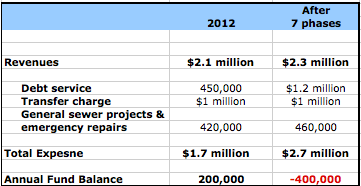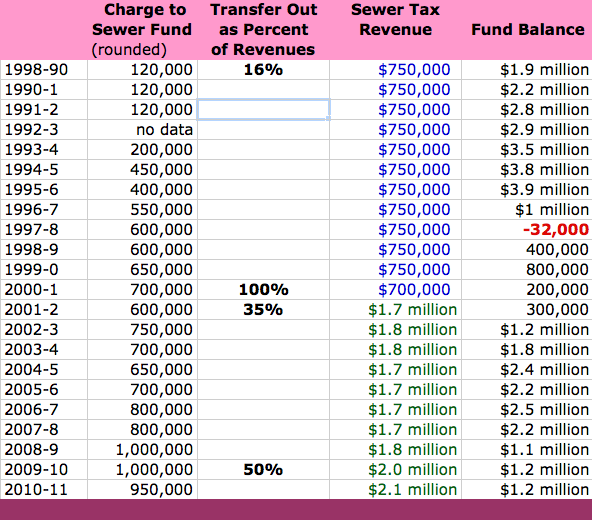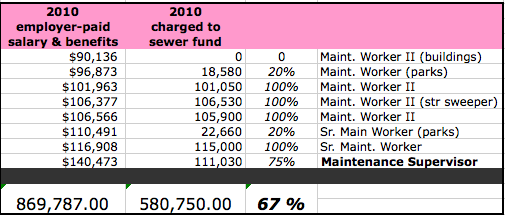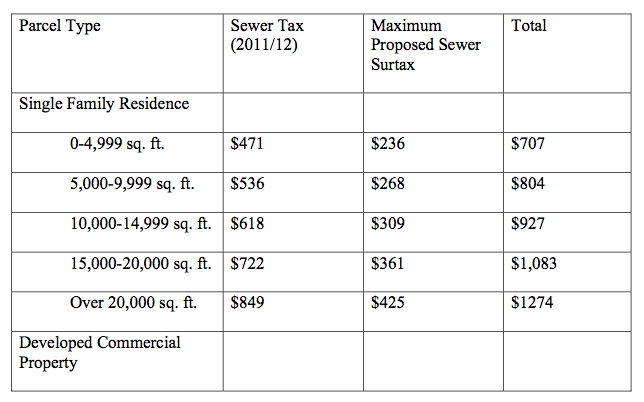Piedmont Sewer Fund Runs Short of Money – Why Are There Deficits?
On the February 2012 ballot is Measure A, the sewer tax surcharge. If approved by voters the current sewer charge of $471- $849 will be increased to a total of $707 – $1,274 depending on lot size (see chart below). The surcharge will remain in place for 10 years with CPI increases. (The sewer tax and surcharge are in addition to the City parcel tax of $342 to $572 which has a term of 4 years.)
How did we get here? The long history of efforts to complete sewer rehabilitation –
Piedmont’s Sewer Fund has insufficient funds to finish rehabilitating 100% of the sewer system by 2018 – a self-selected term of 6 years. New EPA monitoring requirements will increase (rather than create) anticipated Sewer Fund deficits. Extending the timeline for completion of remaining sewer rehabilitation beyond 2018 may decrease sewer fund deficits by allowing revenues to accumulate, but may also increase the need for emergency repair, ongoing maintenance, and other costs.
The Sewer Fund is currently funding two-thirds of the salaries and benefits of maintenance workers, as well as 30% of the cost of the Public Works Director. Large expenditures for emergency repairs and the charge for in-house maintenance work have continued to increase as 60% of the sewer system has been rehabilitated. The history of the Sewer Fund reflects mixed results in the effort to commit funds to sewer system replacement, rather than maintenance.
This will be the second time the Sewer Fund has run short of funds to rehabilitate the sewer system. Piedmont has several options for reducing the Sewer Fund deficits which may be used in combination:
- reduce annual transfers out to the General Fund
- extend tentative timeline for completion of sewer rehabilitation
- approve the proposed Measure A sewer tax surcharge
- make “transfers in” from the General Fund
HISTORY
In the Beginning: Accumulating Funds for Sewer Rehabilitation
A sewer service charge was initially approved in the 1980’s to pay for sewer reconstruction and maintenance. Annual revenues of $750,000 were accumulated, combined with federal grant monies, and used to fund large-scale projects up to $3.3 million described as “sewer rehabilitation”.
The only other expense charged to the Sewer Fund in initial years was a $120,000 “transfer out” to the General Fund. This transfer reimbursed the General Fund for maintenance performed in-house by city workers. Per staff, sewer funds have long been used for related maintenance on the city storm drain system, as well. (See authorizing Ordinance 443 N.S, 1983.) Staff notes $120,000 was an “arbitrary” amount which did not correlate to actual sewer maintenance cost.
Until 1995 84% of sewer revenues went into sewer rehabilitation, while 16% was transferred out to the General Fund. In FY 1995 the annual “transfer out” charge quadrupled to $450,000, leaving less than 50% of annual revenues to accumulate for sewer rehabilitation. The increase was to bring the transfer out amount into line with actual sewer maintenance expense.
By 2001 the transfer out of Sewer Fund to the General Fund had risen to $700,000, virtually 100% of annual sewer revenues, leaving the fund unable to accumulate revenues to pay for larger rehabilitation projects. At the same time, the EPA was insisting on the replacement of 9 sub-basins to reduce overflows of unsanitary water into the bay during heavy rains. The fund was short of money.
The New Paradigm: Tax Increase & State Loans
In 2000, an increased sewer parcel tax was approved by the voters for sewer rehabilitation and maintenance. It doubled the City’s annual Sewer Fund annual revenues from $750,000 to $1.7 million – and included an annual Consumer Price Index (CPI) increase. The City planned to use the funds to undertake rehabilitation of 100% the sewer system in 7 phases.
Phases I, II, and III were quickly completed between 2001-5, addressing the more problematic sewer lines and satisfying a Consent Decree which required the City to replace 9 out of 22 sub-basins. Following a pause of 4-5 years, phase IV was completed in 2010-11. Of the entire sewer system, 60% has now been rehabilitated, including 14 of out of 22 sub-basins.
State loans were used to fund phases I to IV of the sewer rehabilitation (rather than accumulated sewer fund revenues, as previously). The loans carry low-interest rates, although the City incurs $6-700,000 in upfront costs to obtain each loan. Phases V, VI, and VII have not yet been completed (40% of the sewer system and including 8-9 remaining sub-basins).
History of Transfers Out to General Fund
(From $120,000 to $1 million per year)
Running Short of Money Again: Proposed Measure A Surcharge
The above table reflects the transfer charge has risen again – to a level of 50% of current annual sewer revenues. And the Sewer Fund has again run short of money. Current Sewer Fund revenues are not sufficient to cover debt service for all 7 phases on the tentative 2018 timeline, while continuing to make an annual transfer out of $1 million to the General Fund. Earlier staff projections have shown Sewer Fund deficits were anticipated as of 2012-13 before consideration of new EPA compliance costs.
A total cost of $10.5 million to complete phases V, VI, and VII by 2018 has been estimated by staff. The sewer tax will generate $14 million during this period.
 The blue chart illustrates why revenues will be insufficient: debt service will increase when the final 3 phases are completed; general repairs and transfer are not projected to decrease.
The blue chart illustrates why revenues will be insufficient: debt service will increase when the final 3 phases are completed; general repairs and transfer are not projected to decrease.
Measure A, which adds a 50% surcharge to the sewer tax for ten years, has been proposed as one solution to the sewer fund deficit. As with the current sewer tax, the City Council may waive the surcharge for a given year if the extra funding is deemed unnecessary.
Looking at the Transfer Out Charge Details
Actual time spent on sewers and storm drains is not tracked. Six city employees repair, maintain and handle emergencies for the city’s parks, buildings, streets, street sweeping, and sewers and storm drains. Two work on parks the majority of the time. Staff estimates that 50% of the 4 non-park workers’ time is related to sewer and storm drains. All 6 maintenance workers plus an additional city employee may work on storm drains and sewers during emergencies and when needed to cover vacations, illness, etc.
Maintenance Salary and Benefits Charged to Sewer Fund
Supporting detail prepared for the FY 2011 transfer out charge attributes 100% of the cost of 4 workers salaries and benefits to sewers and storm drains, rather than 50%. Two-thirds of the cost of maintenance worker salaries and benefits is funded by the Sewer Fund rather than the General Fund. In addition, 30% of the Public Works Director’s time is charged to sewers and storm drains. In addition, the supporting detail for FY 2011 totals $900,000, while the budgeted transfer out charge equals $1 million.
The transfer out charge does not include emergency repair/reconstruction needs discovered when in-house maintenance is performed. Emergency repair work is performed by outside entities and charged separately to the Sewer Fund under “General Sewer Projects” expense. Though considered emergency work, these repairs have ranged as high as $1.3 million in recent years and tend to vary inversely with the amount of sewer rehabilitation work performed with state loan monies.
Staff notes that the sewer fund is still not attributed with all possible administrative costs. The Public Works Director’s time spent may be more than 30%. Legal costs related to EPA lawsuits and orders have not been allocated to the sewer fund. Staff asserts these costs should be allocated to the sewer fund, but it would not be able to pay them.
Fixing
Piedmont has several options to eliminate deficits faced by the sewer fund, which may be used in combination:
- reduce annual transfer out to the General Fund
- modify the tentative timeline for completion of sewer rehabilitation
- approve the proposed Measure A sewer tax surcharge
- transfers in from the General Fund until 2023
Reduce Annual Transfer Out Charge: Reduction of the transfer out to the General Fund would allow a greater percentage of sewer revenues to be used for long-term sewer rehabilitation work. Actual time and material cost for in-house sewer work could be more closely aligned with the budgeted transfer charge.
Modify the Timeline for Completion: Deficits are based on completing 100% of sewer replacement by FY 2018, a plan that places Piedmont “in the lead” ahead of many other cities. This timeline is tentative, subject to revision, and contingent on the availability of funds. (See Footnote 1.) There is no EPA requirement to complete rehabilitation by 2018.
Lengthening the timetable for completing phase V, VI and VII would tend to reduce Sewer Fund deficits by allowing more funds to accumulate between each phase. Also, loans used to complete the first phases will begin being retired as of 2023, approximately 10 years from now, and debt service cost will decline.
Countervailing reasons to complete work as soon as possible exist: minimizing costs of emergency repair of failed segments, reducing peak EPA monitoring and compliance activity costs, eliminating homeowners’ costs for lower laterals, and reducing overall sewer rehabilitation cost. Interest rate increase and construction cost inflation may also be a consideration, if anticipated to increase.
An analysis of delaying completion has not been undertaken. The MTRC considered accelerating the timeline to save overall costs, but determined insufficient funding would be available to cover upfront costs of securing the loans.
Approve Proposed Measure A Sewer Surcharge: The proposed 50% surcharge would provide $1 million in additional revenues for 10 years with CPI increases. This funding would avoid deficits in the Sewer Fund over the next ten period of increased debt service. (Effectively, the new revenues will offset the annual $1 million annual transfer out to the General Fund, allowing the transfer out to continue indefinitely with CPI increases without impacting sewer rehabilitation funds. However, continued transfers out when actual sewer repairs decline would be inappropriate.) The surcharge will raise sewer costs to taxpayers from $471 – $849 up to $707 – $1,274. Sewer taxes will continue to exceed the city parcel tax ($342 – $572) and be for a longer term of 10 years.
Transfers in from the General Fund: Temporary “transfers in” from the General Fund to the Sewer Fund have occurred in the past. But the General Fund has been running deficits in recent years, drawing down on its reserve balance. The balance could go negative in the next 2-3 years. For this reason, the MTRC, recommended that the Sewer Fund pay all sewer related expenses. However, by not making transfers in, sewer rehabilitation is being given lower priority than all other General Fund expenditures.
__________________________________________________________________________
LINKS to Related Articles:
Sewer Surcharge – and other Piedmont Parcel Taxes – Not Tax Deductible?
Measure A Surcharge – Arguments For and Against
EPA Complaince Costs Come Down
Editor’s Note: PCA Editors would like to thank City staff for the background information and documentation provided on the sewer fund’s history and future estimated costs.
Footnote 1: The EPA will require Piedmont to submit a 10-year Sanitary Sewer Maintenance Plan for rehabilitation and replacement of its sewer lines by July 2012, but the timing of sewer line rehabilitation is tied to availability of revenues and there is no requirement to complete all replacement work within the 10 year plan period ending 2023. Once the plan is in place, deviations from the schedule must be sufficiently explained to avoid penalties. The MTRC (Exhibit 8, p. 3) states
“The timing of each phase [under the SSMP and the 10-year plan required by the discussed in item 3 below] is dependent on the length of the loan process with the SWRCB” as well as keeping city “the debt service at a manageable rate given our funding sources.”
Completion in 6 years, by 2018, would place Piedmont in the lead compared to other cities and the EPA timeline.







Thank you for your detailed investigation into this important issue. I regret that more due diligence into the alternative options you describe was not done before the Council placed the surcharge on the ballot. It’s also distressing that a crucial document, the Technical Advisory Committee report that staff has described as a key link between Piedmont’s Sewer System Master Plan and the “EPA Compliance” line items in the MTRC materials, was not provided in response to my 12/29 public records request or the request of members of the MTRC and has still not been made public.
One threshold claim by proponents in support of the proposed sewer surcharge is the “City of Piedmont must comply with the 2011 EPA order requiring additional rehabilitation.” This fundamental assertion appears twice in Proponent Ballot Arguments and elsewhere in staff documents. A reading of the 2011 EPA order (3:09-cv-05684-RS filed: 3/15/2011) contains no such language and this is independently confirmed by attorney Tom Clark. Irrefutably, the EPA Compliance Officer for the 2011 order wrote: “the Stipulated Order does NOT [emphasis added] specify a deadline by which Piedmont must complete the mainline sewer replacement work, nor is there a stipulation for penalties to be assessed against Piedmont if they fail to replace or repair a certain length of pipe each year.” (EPA 11/23/2011 & 12/29/2011 emails)
To give Staff an opportunity to correct the record, I made a PRA request on Dec. 26 asking for “citation from any administrative or stipulated order, or any other document received by the City from the EPA, that requires main (sewer) replacement.” Staff referred to “docket #: CWA 309(a)-10-010 (Administrative Order) Section VI on Page 15.” Sec. VI requires annual reports “documenting sewer repair, rehabilitation, or replacement activities in the previous year [and] to be completed in the coming cycle.” This language in Sec. VI is requiring documentation of activity, the language clearly does not specify mainline replacement.
Editor’s Note: The EPA requires only that $460,000 be “set aside” in a special account for Main Replacement and emergency repairs every year. The City anticipates requesting EPA permission to credit its planned rehabilitation work (Phases V, VI, and VII projected at $3 million every few years.) to satisfy this “set aside”. Alternatively, phased work and/or general sewer project work could be structured to ensure spending $460,000 each year. There is no EPA requirement to replace all sewer mains in 3 phases, or by 2018. The $460,000 set aside is aimed at other cities which are allocating $0 to replace sewer lines.